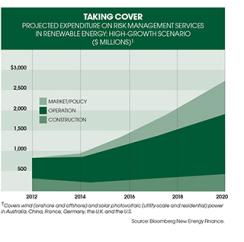Eric Starr knows where his expertise lies, and it’s not in sizing up solar panels and estimating energy savings. A New York–based partner at $225 million CapX Partners, which invests in middle-market U.S. companies in the energy, technology, manufacturing and health care sectors, Starr is more comfortable with balance sheets than with engineering reports.
But in 2011 he and his team at Chicago-based CapX noticed that, owing to a lack of technical knowledge, investors weren’t capitalizing on a big chance to finance energy-efficient retrofits of commercial and residential buildings. In the U.S. the retrofit market is worth between $4 billion and $6 billion annually, according to a 2012 report co-authored by the New York–based Rockefeller Foundation and DB Climate Change Advisors; without giving a time frame, the report puts the potential U.S. investment opportunity at more than $279 billion.
CapX found a solution in Energi Insurance Services, a provider of insurance programs for energy retrofits and other alternative-energy projects. Energi is part of a growing risk mitigation market that could make the renewable-energy space more attractive for institutional investors. “There is a large percentage of opportunity that we would not consider without the Energi product,” Starr says.

In Australia, China, France, Germany, the U.K. and the U.S., annual spending on risk management services for wind and solar energy projects could triple by 2020, to $2.8 billion, according to a July report by London-based research firm Bloomberg New Energy Finance and Zurich-based Swiss Reinsurance Co. During that time total wind and solar investment in those six markets will probably jump 50 percent, to $120 billion a year, the authors say.
The policies sold by Energi and its competitors can alter the risk-return profile of an alternative-energy project enough to sway an investor. “In many cases the investor is the key driver in purchasing the policy, as they may require this type of insurance coverage or give preferential treatment to projects that incorporate performance insurance,” says Angela Ferrante, Energi’s vice president of alternative-energy solutions.
CapX has partnered with Energi to offer insurance on CapX’s online Energy Conservation and Performance (Ecap) platform, slated to launch on October 12. Builders and other parties seeking financing can enter project details on Ecap; if a project is insurable, it’s more likely that CapX will say yes.
Institutional investors are helping to drive demand for green energy insurance. Falling conventional-power prices and recession-related pressure have pushed major utilities, especially those in Europe, to pull out of many renewables projects, notes Juerg Trueb, Zurich-based head of environmental and commodity markets at Swiss Re Corporate Solutions. As a result, merger and acquisition activity has surged, and more institutions are entering the market.
PensionDanmark, whose $25.8 billion in assets under management make it Denmark’s largest pension fund, has allocated some $1 billion to green infrastructure. In June, for example, the fund committed $200 million to Boston-based Cape Wind Associates’ proposed wind farm near Cape Cod, Massachusetts. Copenhagen-based PensionDanmark plans to make $2 billion worth of similar investments over the next four to five years.
“Because institutional investors have a different risk appetite, the demand for solutions that shape the risk-return profile of renewable-energy assets has increased,” says Swiss Re’s Trueb. The insurance products on offer fall into two broad categories, he explains: those like Energi’s, which cover new projects against production problems related to construction, and those that insure existing projects against market risks such as price changes and weather conditions. “The latter type are relatively new, and we see heightened demand for such coverage, especially from institutional investors, as they are looking for long-term, stable yields,” Trueb says. • •
Read more about banking and capital markets.






